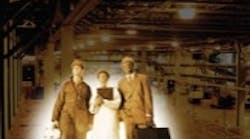If you visit some warehouses and DCs around the country early in the morning, you may see prison busses pulling up and unloading convicts, who enter the warehouses and spend the next eight hours working inside, being picked up at the end of the day by the busses and transported back to prison. No, this isn't the plot of some strange Hollywood movie. It's reality. "Some sheriff's departments around the country have programs where prisoners are allowed to work during the day," says Daniel Bolger, P.E., president of The Bolger Group (Millersport, Ohio, www.bolgergroup.com), a management consulting firm. "The sheriff usually arranges to drop the workers off in a bus and pick them up at the end of the shift. A portion of their earnings go back to the sheriff's department to cover incarceration costs." Most of these programs are managed through local temp agencies, which take care of workers' compensation issues, etc.
A good idea? It depends. "Most of these programs work with prisoners living in community transition homes, which tends to be low security," says Bolger. "These are not mainstream prisoners."
That's one way to get temporary workers. There are others. And these days, warehouse and DC managers are looking for as many different options as possible, because some previously reliable sources have dried up, and un employment figures are low in many parts of the country. "There was a time when it was common to hire school teachers and shiftwork firefighters as temps," says Bolger. "As pay scales have increased, though, these people tend to be less available for temp work."
Some managers work with local colleges and hire students as temps. However, according to Bolger, because of benefits programs, workers' comp, liability insurance, etc., it may make more sense to work through an professional temp agency.
One exception to working through an agency, though, might be to consider hiring family members of full-time employees. "For example, your full-time workers may have children who are available to work during the summer or other times when you have a need for temps," says Bolger. The benefit here is that, if the full-time workers are reliable, there's a good chance they will make sure their children (or other relatives) will be equally reliable.
Agency Options
Of course, when it comes to hiring temps, the most com mon route is to work with traditional temp agencies, which will work to fill requirements of a number of different job positions for companies in a number of different industries. But it's also worthwhile to consider some specialty agencies.
One of these is AfterCollege, Inc. (San Francisco, Calif., www.aftercollege.com), the largest college Web-based employment network in U.S., which works with individual academic departments to help their students connect with employers. "For warehouse and DC workers, we work with college logistics and supply chain departments," says Roberto Angulo, CEO. Warehouses and DCs can post their job openings on the agency's website for entry-level jobs part-time throughout the year, during the summer, and even for internships.
One benefit of hiring college students as temps, according to Angulo, is that you end up getting people who are eager to learn about your specific industry, since this is what they are majoring in in college. "For this same reason, the program provides an excellent source of people to consider for permanent jobs, who can even move up in your organization," he says.
Another specialty agency is Lift Temp Industrial (Mississauga, Ontario, Canada, www.lifttemp.com), which has offices in Canada and the U.S. The company offers positions for general labor and lift truck operators, as well as all other warehouse positions. The agency specializes in providing certified and experienced lift truck operators. "We have our own lift truck training center, where we train, qualify, and certify operators," says Sheri Brimley, president. Some of the people are trained in distribution, shipping/receiving, and some are trained in supervision and management.
"We won't place temporary employees with a client until we have done a full tour of the facility ourselves," says Richard Jones, vice president. "We want to make sure the work environment is safe. They are our employees, so we have a responsibility for them, and we want to ensure their safety."
To get the workers off on the right foot when they start the job, Lift Temp provides training, but the client is expected to provide an orientation of their workplace, training on the specific work procedures, and information on their health and safety policies.
"When selecting a temp agency, look at value, not just cost," says Brimley. "For example, damage to product and equipment will be far less with a trained and competent lift truck operator." And, according to the company, the benefits of using trained temps are that the retention tends to be higher, the workers are more satisfied, safety is better, product damage is reduced, and maintenance costs of equipment are reduced.
Good Shepherd Work Services (Allentown, Pa., www.goodshepherdrehab.org) has been in existence for 50 years. Among its many services, it helps place individuals with disabilities into the workplace. "Walgreen's is one large company that uses our workers in many of its distribution centers," says Tim Hayes, administrator. "We have been working with them for over ten years, and many of our workers have eventually been hired by Walgreen's."
Good Shepherd provides employers with information on any specific work accomodations that the workers may need. There is a misconception that these accomodations tend to be very expensive, according to Hayes, but that is rarely the case. "Most of them are simple, easy, and inexpensive to implement," he says.
According to George Wells, coordinator, transitional employment ser vices, for Good Shepherd, research shows that people with disabilities compare favorably with the general population in terms of work skills, work traits, loyalty, attendance, and productivity, as long as there is good matching.
Wells cites some benefits: "When we send a work crew of four to seven people to a warehouse, we also ar range to send a lead worker, who is responsible for supervising the crew and also does the same work," he says. This reduces the need for the client to arrange for in-house supervision. Good Shepherd also has access to certain funding streams that allow it to provide training and coaching to the workers, at no charge to the clients. "There are also federal and state tax credits for employers to hire people we provide," he says. In some cases, employers can even get certain pieces of equipment free of charge, up to $15,000, if the equipment is going to be used by workers with disabilities.
On-The-Job Supervision
Once you have the right temps on the job, the next step is to make sure they are properly acclimated and then able to perform the necessary tasks.
The best way to begin, according to Don Cook, president of Cook and Associates (New Brunswick, N.J., www.cookpep.com) is to design your operations properly. "You have minimum training time available to bring temps up to speed, so you need to structure work tasks in advance as much as possible, so temps can be brought in to do very simplified portions of the tasks," he says. For example, you may want to have them focus on packing or unpacking, rather than using electronic scanners for checking in merchandise.
How can you determine if temps are "earning their keep"? According to Cook, when you look at labor costs, be sure to include temp costs. "Some companies have work and productivity measurement programs for their regular employees, but don't include temps in the program," he says. Cook and Associates offers Productivity Evaluation Program (PEP), which includes performance measures for temps. Certainly, though, you can't expect temps to meet the same standards as regular employees. "We tell clients that it is OK for them to expect temps to perform 10% to 20% lower than regular employees," he says.
After the temps have been measured, the program provides the client with a list of the names of the temps who should no longer be acceptable to the client. This list can be kept on permanent file so the client doesn't end up hiring those same temps again from that or an other agency. "We also provide a list of high-performing temps, which the client can then consider for hiring," says Cook. The program also keeps track of temp productivity by temp agency. One client using PEP told temp agencies that it would give more business to the agencies whose employees had the best productivity, which was an incentive for the agencies to send their best workers.
Core e-Business (Fairlawn, N.J., www.coreebusiness.com) is another company that provides warehouse worker performance software. Not only does the software measure engineered labor standards for fulltime employees and temps to compare them, it also measures temps against each other, so clients can identify the best ones and consider bringing themon as fulltime workers.
Howard Mintz, chief operating o~cer of Core e-Business, offers a recommendation for getting the most from new temps: "Integrate them into the workforce efficiently," he says. "For example, if you utilize RF technology and manual paper-based processes, it may make sense to have fulltime workers use the RF technology and have the temps use the paper-based processes."
Temps in Action
APL Logistics is one company that actively utilizes temps in its warehouse and DC locations in the Americas. Because it is so large, APL has national accounts with some temp agencies. However, not all of them have been able to ˛ll its needs in all of its locations. As such, if an APL location is able to use one of the national contracts, it does. However, if not, the location is free to use a local temp agency.
Currently, about 42% of APL's warehouse manhours are ˛lled by temporary employees, according to Dixie Brock, national warehouse safety manager, who is located at APL's Bloomington, Illinois, office. "Some locations use mostly temps," she says. "Others only use them on occasion for special projects."
Training and acclimating are very important to APL and the temp agencies with which it works. "Some temp agencies actually bring the temps to the warehouse in advance to show them what the work will be like," she says. "This lets the temps know in advance whether it will be work that they would want to do." Some of them decide this isn't a job they want to do before they even start, which helps reduce turnover and other problems from the beginning.
"We also discuss training with the temp agency right up front, and they address much of the training before the temps even come in the door, including general warehouse safety requirements from OSHA," she says. The agency actually brings the temps to the warehouse for this training before they start work. Then, once the temps actually start, APL provides training that is more speci˛c to the individual warehouse. "We also have monthly training for all employees, and temps participate in this, too," she says.
APL tracks the performance of its full-time employees and its temps in each of the warehouse locations. "While 42% of our manhours are filled by temps, only 27% of our in juries occur to temps," says Brock. "This shows that they are getting the training that they need."




